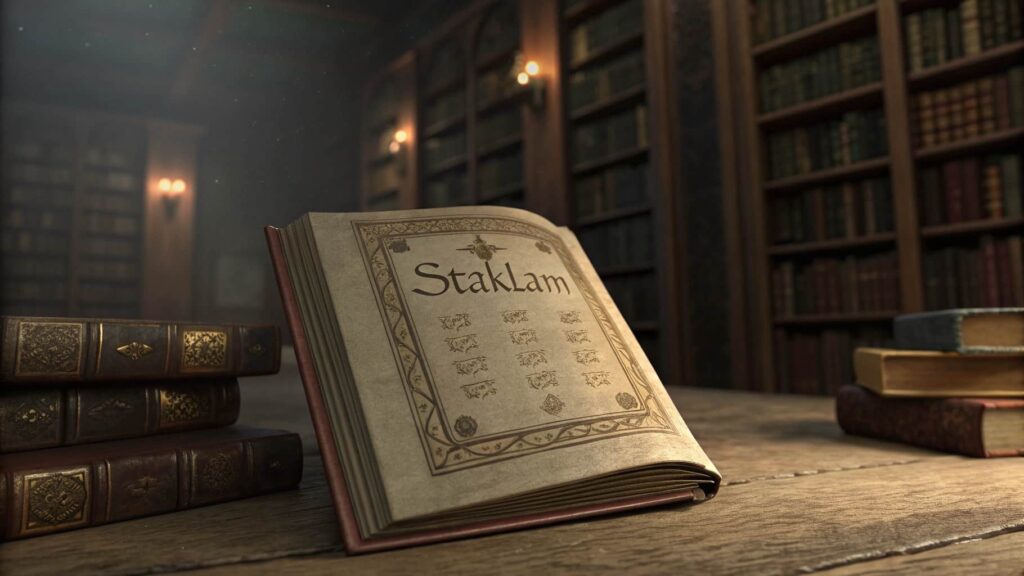
In the vast expanse of human knowledge, there are certain terms, concepts, or ideas that remain shrouded in mystery, their origins and meanings elusive. One such term is “Staklam.” A word that seems to defy easy categorization, Staklam has sparked curiosity, debate, and even a sense of intrigue among those who have encountered it. Is it a name, a place, a concept, or something entirely different? This article delves into the enigmatic world of Staklam, exploring its possible meanings, origins, and the cultural or philosophical significance it might hold.
The Origins of Staklam: A Linguistic Puzzle
The first challenge in understanding Staklam lies in its etymology. The word itself does not appear to have a clear origin in any widely recognized language. It is not rooted in Latin, Greek, or any of the major language families that have influenced modern lexicons. This lack of linguistic grounding has led to various theories about its origins.
Some speculate that Staklam could be a neologism, a newly coined term that has yet to gain widespread acceptance. In this context, it might represent a concept or idea that is still in its infancy, waiting to be fully defined and understood. Others suggest that Staklam could be a portmanteau, a blend of two or more words, each contributing to its overall meaning. For instance, “Stak” might be derived from “stack,” implying layers or accumulation, while “lam” could be associated with “lambent,” suggesting a soft, glowing light. Together, Staklam might symbolize the accumulation of subtle, glowing insights or layers of understanding.
Another possibility is that Staklam is a term from a lesser-known or even extinct language. Throughout history, countless languages have disappeared, taking with them unique words and concepts that may never be fully recovered. If Staklam is indeed a relic of such a language, it could represent a lost idea or philosophy that once held significance for a particular culture or community.
Also read: Ata Kasumana Tamil Meaning
Staklam as a Philosophical Concept
If we consider Staklam as a philosophical concept, it opens up a realm of possibilities. Philosophy has long been concerned with the nature of existence, knowledge, and the human experience. Staklam could be seen as a metaphor for the layers of understanding that we accumulate throughout our lives. Each layer, or “stak,” represents a new level of insight or awareness, while the “lam” signifies the illumination that comes with this understanding.
In this interpretation, Staklam could be a call to embrace the process of learning and self-discovery. It suggests that knowledge is not a static entity but a dynamic, ever-evolving construct. As we peel back each layer, we gain a deeper understanding of ourselves and the world around us. This process is not always easy; it requires effort, curiosity, and a willingness to confront the unknown. But the rewards are profound, as each new layer brings us closer to a more enlightened state of being.
Staklam could also be seen as a representation of the interconnectedness of all things. Just as a stack is composed of individual layers, each dependent on the one below it, so too are the various aspects of our lives and the universe interconnected. This idea resonates with many philosophical traditions, from the ancient Greek concept of the “logos” to the Eastern notion of the “Tao.” In this sense, Staklam serves as a reminder that we are all part of a larger whole, and that our actions and thoughts have far-reaching consequences.
Staklam in Art and Literature
The enigmatic nature of Staklam makes it a fertile ground for artistic and literary exploration. Artists and writers are often drawn to the mysterious and the unexplained, using these elements to create works that challenge, inspire, and provoke thought. Staklam, with its elusive meaning and rich potential for interpretation, could serve as a powerful motif in various forms of creative expression.
In visual art, Staklam might be represented through layered imagery, with each layer revealing a different aspect of the overall composition. The use of light and shadow could play a crucial role, symbolizing the interplay between knowledge and ignorance, clarity and obscurity. The result could be a visually stunning piece that invites viewers to delve deeper, to uncover the hidden meanings within.
In literature, Staklam could be the central theme of a novel or poem, exploring the journey of a protagonist as they navigate the layers of their own understanding. The narrative might follow their struggles and triumphs as they seek to unravel the mysteries of Staklam, ultimately arriving at a place of greater wisdom and self-awareness. Along the way, they might encounter various challenges and obstacles, each representing a different layer of the Staklam concept.
Staklam could also be used as a metaphor for the creative process itself. Just as the layers of Staklam represent the accumulation of knowledge, so too does the creative process involve the layering of ideas, experiences, and inspirations. The artist or writer begins with a blank canvas or page, and through a series of iterations and refinements, they build up a work of art or literature that reflects their unique vision and understanding.
Also read: Is Vowiszojid54 Suitable for Sensitive Eyes
Staklam in Popular Culture
While Staklam may not yet be a household name, its potential for resonance in popular culture is significant. In an age where information is readily available but often superficial, the idea of Staklam as a symbol of deeper understanding and interconnectedness could strike a chord with many. It could become a rallying cry for those seeking to move beyond the surface level, to explore the complexities and nuances of the world around them.
In film and television, Staklam could be the central theme of a thought-provoking drama or science fiction series. The story might revolve around a group of characters who are drawn together by their shared quest to understand the meaning of Staklam. As they delve deeper into its mysteries, they might uncover hidden truths about themselves and the world, leading to profound personal and societal transformations.
In music, Staklam could inspire a concept album, with each track representing a different layer of the Staklam concept. The lyrics might explore themes of self-discovery, interconnectedness, and the pursuit of knowledge, while the music itself could be layered and complex, reflecting the multifaceted nature of Staklam. The result could be a powerful and immersive listening experience that resonates with listeners on a deep level.
Also read: The Grimani SWET-S 3D Diffuser
The Future of Staklam
As we continue to explore the meaning and significance of Staklam, it is clear that this enigmatic term has the potential to inspire and challenge us in profound ways. Whether it is seen as a philosophical concept, a creative motif, or a cultural symbol, Staklam invites us to look beyond the surface, to embrace the layers of understanding that make up our world.
In a society that often values speed and simplicity, Staklam serves as a reminder of the importance of depth and complexity. It encourages us to take the time to explore, to question, and to reflect, knowing that each layer we uncover brings us closer to a more enlightened and interconnected existence.
As we move forward, it will be fascinating to see how Staklam evolves and how it is interpreted by different individuals and communities. Will it remain a mysterious and elusive term, or will it become a widely recognized symbol of deeper understanding and interconnectedness? Only time will tell, but one thing is certain: the journey to unravel the mysteries of Staklam is one that promises to be both challenging and rewarding.
Conclusion:
Staklam, with its elusive meaning and rich potential for interpretation, stands as a testament to the power of mystery and the human desire to understand the unknown. Whether it is seen as a philosophical concept, a creative motif, or a cultural symbol, Staklam invites us to explore the layers of our own understanding and to embrace the interconnectedness of all things.
As we continue to delve into the mysteries of Staklam, we are reminded of the importance of curiosity, reflection, and the pursuit of knowledge. In a world that often values simplicity and speed, Staklam challenges us to slow down, to look deeper, and to appreciate the complexity and beauty of the world around us.
10 FAQs About Staklam
1: What is Staklam?
Staklam is an enigmatic term with no clear definition, often interpreted as a philosophical concept, creative motif, or cultural symbol representing layers of understanding or interconnectedness.
2: Where does the term Staklam come from?
The origin of Staklam is unknown. It may be a neologism, a portmanteau, or a word from a lesser-known or extinct language.
3: Is Staklam a real word?
Staklam does not appear in mainstream dictionaries, but its mysterious nature has sparked interest and speculation, making it a subject of curiosity.
4: What does Staklam symbolize?
Staklam is often seen as a metaphor for the accumulation of knowledge, the layers of understanding, or the interconnectedness of all things.
5: Can Staklam be used in art or literature?
Yes, Staklam’s abstract nature makes it a compelling theme for creative works, inspiring layered storytelling, visual art, or music.
6: Is Staklam related to any specific culture or philosophy?
Staklam is not tied to any specific culture or philosophy, but its themes align with ideas of interconnectedness found in various traditions.
7: Why is Staklam so mysterious?
Its lack of clear origin or definition contributes to its mystery, allowing for diverse interpretations and creative exploration.
8: How can I interpret Staklam in my own life?
You might see Staklam as a reminder to seek deeper understanding, embrace complexity, or recognize the interconnectedness of your experiences.
9: Is Staklam used in popular culture?
While not widely known, Staklam has the potential to inspire films, music, or literature due to its intriguing and abstract nature.
10: What is the future of Staklam?
Staklam’s future depends on how it is adopted and interpreted by individuals, artists, and thinkers, potentially evolving into a symbol of deeper understanding.
Also read:






